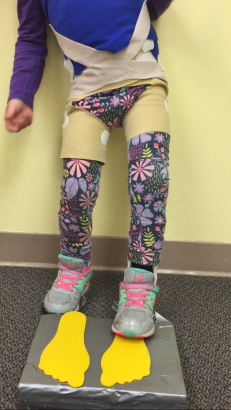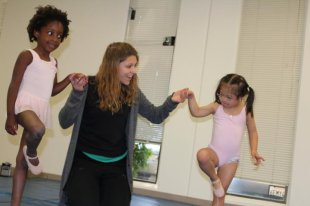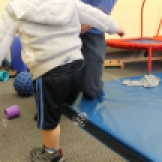I recently had a parent ask about ideas to help her child who has weakness on one side of her body more than the other side. I figured I would write about some of the ideas that I use although please be aware that there are a ton of ideas and it depends on the developmental stage your child is at and specifically what skills they are working on. For this case I am going to give ideas for kids that are working on skills such as walking or stair climbing. I’m going to look at ideas for encouraging the use of both legs more equally. (In order to differentiate the legs I will talk about them as the weaker and stronger leg, hopefully this does not offend anyone)

Climbing – I love having kids crawl up and down steps. This is a great way to work on both sides of the body together but still encourage them to activate the side that is weaker. It works on developing reciprocal activity (which is needed for walking and crawling) as well as motor planning, coordination and leg strength (especially the butt muscles). Make sure your kiddo is switching legs as they try to crawl up, using one knee on the next step up and then shifting their weight onto that leg as they bring the other leg up. Make sure they are shifting their weight onto the leg that is leading so that they are practicing weight shifting as well as taking maximal advantage of the opportunity to develop leg strength. They may need a little help especially if it is the weaker side. Make it motivating by putting a favorite toy a few steps above them or using a toy with multiple pieces that they need to go up and down to get all the pieces (i.e. puzzles).

Up and Down Hill – Walking up and down inclines can also work to help your kiddo develop strength equally on both sides. Especially on the way up they have to engage their butt muscles in order to keep their balance and on the way down they need to maintain control so they don’t crash. You can have them walk or crawl up and down the hills.
Step Ups and Downs – If your child is standing and walking already then working on step ups and downs is a great activity. I like to use smaller stairs and encourage the kiddo to go up leading with their weaker leg and come down leading with their stronger leg. This way the leg that isn’t as strong gets to develop strength and power as it lifts the kiddo up to the next step and it develops control as it lowers the kiddo down onto the next step. If your kiddo can ‘cheat’ while on the stairs then find a few phone books you can tape together or a step stool that is at a height that is challenging but they can have success (usually with a little support). When I work on these kind of skills I pretend we are going over a mountain and usually I have bean bag animals or puzzle pieces on one side and their ‘home’ on the other side so that they think they have a purpose in going over the step over and over. Same rules apply, stepping up you put the weaker leg on the step and going down you leave the weaker leg on the step.

Single Leg Stance – Now this can be challenging if your kiddo can’t fully stand or balance on one leg by themselves yet. Here are some ideas to help that skill evolve as well as work on keeping their weight on the weaker leg. You can have your kiddo stand with the stronger leg up on a slight height like a phone book or a step stool and play with them. If they have challenged balance you may need to stand close by. You could have them stand like this while playing with magnets on the refrigerator, drawing at an easel, playing games on an ipad, etc. Just make sure they aren’t leaning on the support surface too much! Another way to encourage single leg stance and shifting onto their weaker leg is to use a stomp rocket. The stomp rocket is a toy that is so much fun! Have them use their stronger leg to stomp on it which makes them have to stand on their weaker leg. As they get better at this you can have them hold their foot up for a count of (1,2,3,etc) before they are allowed to stomp. Depending on how good their balance is you may have to give them a slight hand (not too much support) while they balance before stomping.

Kicking a ball – Have them practice kicking a ball. You can have the ball be standing still or it can be rolling towards them (depending on their level). In order to pick their foot up to kick the ball they will need to balance on their weaker leg.
The above ideas all can help with stability and strength on their weaker leg. If you are looking to have them work on lifting their foot more with things like walking then you can reverse some of the activities I listed or you can also try some of the ideas I talked about for improving foot clearance.
Please share other ideas!














